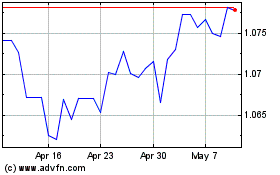U.S. Dollar Extends Fed-Induced Rally
October 30 2014 - 1:25AM
RTTF2
The U.S. dollar is higher against the other major currencies in
the Asian session on Thursday, building on the gains recorded in
the New York session yesterday following the FOMC announcement.
The Federal Reserve signaled an end to its quantitative easing
by slashing purchases of Treasuries and mortgage-back securities to
zero from $15 billion.
Policymakers repeated their pledge to keep interest rates around
their record lows for "a considerable time," but said interest
rates may rise sooner than markets expect if the economic recovery
continues to gather steam.
The Fed ended its so-called QE3 program after US unemployment
rate dipped to 5.9 percent in September, a six-year low.
Policymakers also sounded more hawkish on inflation despite a
significant recent drop in prices at the pump.
The vote to end QE was 9-1, with Minneapolis Fed President
Narayana Kocherlakota dissenting on the grounds that QE3 should
have been sustained.
On Wednesday, the U.S. dollar rose 0.80 percent against the
euro, 0.74 percent against the pound, 0.40 percent against the
Swiss franc and 0.71 percent against the yen.
In the Asian trading, the U.S. dollar rose to nearly a 4-week
high of 109.10 against the yen and more than a 2-week high of
0.9558 against the Swiss franc, from yesterday's closing quotes of
108.88 and 0.9547, respectively. If the greenback extends its
uptrend, it is likely to find resistance around 110.21 against the
yen and 0.97 against the franc.
Against the euro and the pound, the greenback climbed to a
1-week high of 1.2615 and a 2-week high of 1.5965 from yesterday's
closing quotes of 1.2630 and 1.6010, respectively. The greenback
may test resistance near 1.24 against the euro and 1.58 against the
pound.
Meanwhile, the Australian dollar also fell against the other
major currencies amid the dollar strength, which has exerted
downward pressure on commodities.
In economic news, the Housing Industry Association showed that
the total number of new home sales in Australia was roughly flat on
month in September following the 3.3 percent jump in August. Among
the individual components, the sale of detached houses dropped 2.3
percent, while the sale of apartments surged 11 percent.
The Australian dollar fell to 6-day lows of 0.8759 against the
U.S. dollar and 0.9807 against the Canadian dollar, from
yesterday's closing quotes of 0.8796 and 0.9834, respectively. The
aussie is likely to find support around 0.86 against the greenback
and 0.96 against the loonie.
Against the yen and the euro, the aussie fell to 2-day lows of
95.37 and 1.4411 from yesterday's closing quotes of 95.77 and
1.4355, respectively. The aussie may test support near 93.38
against the yen and 1.45 against the euro.
Looking ahead, UBS Swiss consumption indicator index for
September, KOF's leading indicator index for Switzerland, U.K.
Nationwide house prices and German unemployment data for October
are due to be released in the European session.
At 3:45 am ET, Bank Of England Deputy Governor Jon Cunliffe will
deliver a speech at the Wessex Chambers Networking Business
Breakfast, in Bradford on Avon.
In the New York session, Eurozone business climate indicator
index and economic confidence index for October, advance estimate
of third quarter U.S. GDP, U.S. weekly jobless claims for the week
ended October 25 and German CPI data for October are due to be
released.
At 9:00 am ET, U.S. Federal Reserve Chair Janet Yellen will
deliver opening remarks at the Board of Governors of the Federal
Reserve System's National Summit on Diversity in the Economics
Profession in Washington DC.
Euro vs US Dollar (FX:EURUSD)
Forex Chart
From Mar 2024 to Apr 2024

Euro vs US Dollar (FX:EURUSD)
Forex Chart
From Apr 2023 to Apr 2024
